General
Last November, mindat.org, the awesome internet mineralogical database and forum, plus the Spirifer Geological Society, from Poland, organized a mineralogical conference in Morocco. The conference featured speakers from around the world and was accompanied by extensive field trips, before and after the conference, to classic mineral localities in Morocco. My collecting partner, Ray McDougall and I learned about it a full year earlier, when it was originally promoted. We were two of the first people to sign up! It just seemed like a wonderful opportunity! The registration was sold out a month or so later.
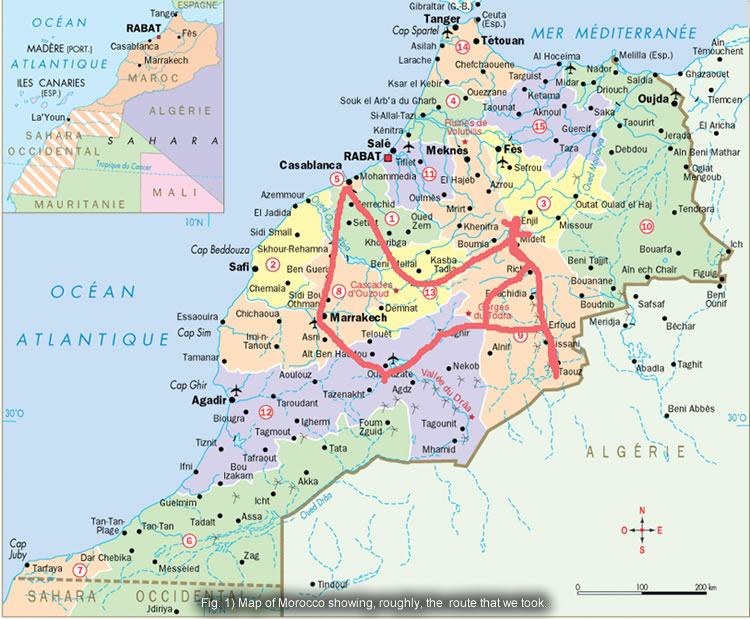
Morocco has been, for many decades, a country that has produced great mineral specimens. Names like Mibladen, Imiter, Bou Azer and many others have become familiar names to people who are interested in well crystallized, beautiful and/or rare minerals. As an admirer of Moroccan silver and proustite from Imiter as well as skutterudite and gersdorffite from Bou Azer, I was keen to have a chance to collect or acquire some of these specimens closer to the source.
The main raison d’etre of the conference and field trips was the study minerals of and the field collecting of mineral specimens. A huge bonus, however, was the social program. The organizers went out of their way to ensure that there were ample opportunities to socialize and learn about Moroccan culture. Every evening there was a large group supper and conversations were lubricated with nice wines and copious quantities of vodka from Poland. Every evening, there were local artists performing Berber music, snake charming or belly dancing. The food was all served group or buffet style and selection was fantastic! Many evenings were spent chatting with mineral lovers from all over the world while listening to great music and nurturing glasses of Krupnik, a Polish honey-dosed vodka.
About Morocco
I’ll just give a brief outline of my observations and impressions about Morocco. I really cannot do it justice from just a two week visit but I’ll let you know what I know!
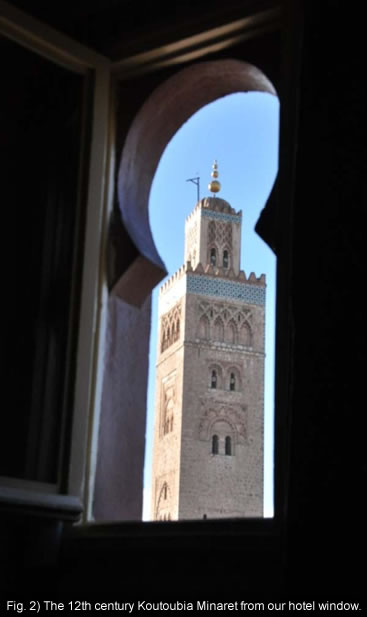
Morocco is a land of contrasts. The northern coast, where we started our trip is rich with urban life in the cities of Casablanca, Marrakech, Rabat and others on the coast. Just outside of the cities, and all the way to the base of the Atlas mountains are rich agricultural areas that skillfully use the soil and judicious use of water to grow many fruits and vegetables. Morocco is an agricultural country! We observed the most modern of farms, infrastructure and transportation systems to the most primitive, such as people tilling the soil by hand and riding on donkeys.
Closer to the mountains, the image of Morocco changes to one of livestock and tougher forms of subsistence living. Everywhere we went, we saw goatherds and shepherds with their flocks, probably doing things the same way that they have for thousands of years. On the other hand we saw the most modern trucks and cars on the same roads as the people on donkeys. Any piece of arable land in the mountains has a bit of pasture on it or water from a local river diverted to it to grow food.

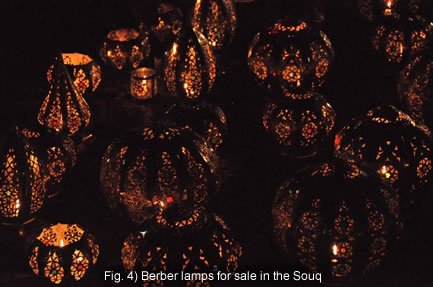
Once you are over the mountains, the land and climate turns to desert. Not the desert that you think of with sand dunes, but a rocky, barren desert with oases and irrigated farm lands. The Moroccans have become very good at drilling deep wells to obtain water to produce farmland from desert. Everywhere, in the desert, there are people tending flocks of sheep or herds of goats. As well, it is very common to see nomadic people with small herds of camels moving them around an area fairly close to their tents.
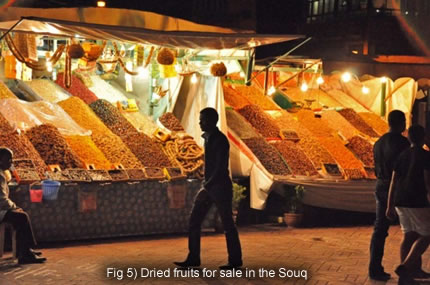

The official language of Morocco is Arabic and that is what I heard spoken most often. It seemed that, in the regions where we were, most people speak some measure of French, as well. I’m glad, again , to be able to speak some French and that was always the language of conversation or business during my stay in Morocco. Rarely English.
We saw many modes of dress during our travels. As a general rule, people in the cities were dressed in more modern garb with some people dressed in traditional dress. In the country, it was the other way around with, I think, with a large proportion of people dressed in more traditional clothing.
Marrakech Area

We flew into Casablanca and were picked up by a shuttle arranged for by the conference organizers. We were whisked to Marrakech along a modern highway and before we knew it, we were ensconced in our hotel, a classic oldy, in downtown Marrakech. We were surrounded by mineral loving friends, old and new, excited about the prospects for collecting interesting and unique mineral specimens at a number of classic localities. The first night we were treated to a Moroccan musical group who played folk music and then were joined by a belly dancer, later in the evening. Acquaintances were renewed and many people finally met others that they had read about or had corresponded with.
The hotel was right downtown near the souq and right across the road from the Koutoubia minaret. Every morning at 6:30am or so we were blasted out of bed by an ear splitting call to worship by an imam over the loudspeakers. There was much history around us. The minaret was constructed in 1200AD or so. There were many other buildings that reflected the ancient history of the area.
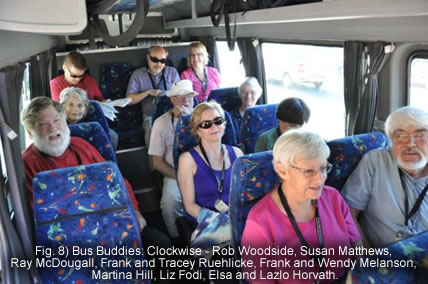
The transportation method selected by the organizers was a fleet of minibuses that each held 15 or so people. Our bus held all Canadians, plus a driver. Not luxurious but, most of the time comfy. I was, somehow, appointed “fearless leader” of the bus. I preferred “exalted leader” but my crew didn’t seem to want to genuflect to that extent. My job was to try to gather information from the organizers and bring it to the bus or to take concerns and suggestions from the bus to the organizers. We had some fun times on the bus!
Sidi Rahal
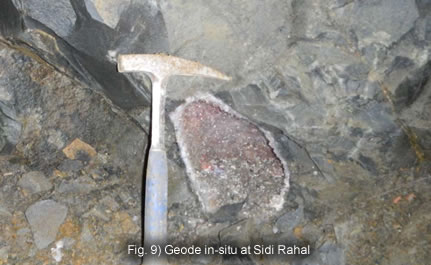
The first field trip was to the geode locality at Sid Rahal. The locality is a thick bed of basalt that featured geodes, large and small and collecting was actually fairly easy. Unfortunately the road was washed out due to the torrential rain the day before but some of the buses made it through. These type of busses were not really made for this type of road and some of the drivers were upset at the conditions. Our driver went on strike! So some of us walked in and out of the locality from where our bus was. We only had a couple of hours to collect but even so a number of people came up with respectable finds. The geodes varied greatly and consisted of quartz crystal lined geodes, agate lined geodes or agate filled geodes. Some of the quartz was colourless and some was amethystine. The agates ranged from pure white to banded red fillings, sometimes with drusy quartz interiors. There were lots of Moroccan collectors walking around trying to sell us specimens while we collected, including kids. I purchased a really nice little geode from the little guys pictured below. One of the local geode dealers put up a sumptuous traditional lunch of tea, olives, dates, almonds and breads that we enjoyed thoroughly. After lunch the attendees visited the various geode dealers in the area and, many picked up nice specimens at reasonable prices.
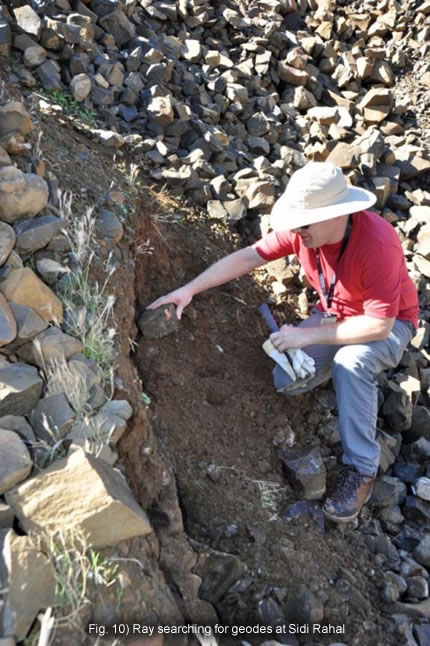
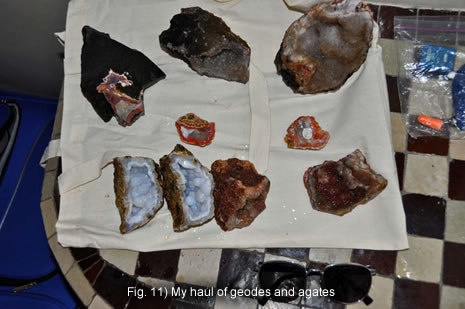
Marrakech is along way from the great mineral collecting localities so we spent a whole day travelling to Ouarzazate. It was a lot of time in a mini bus but we did stop a number of times for “bio breaks”, scenery admiration and many, many mineral stores. There are a LOT of rock shops in Morocco! We headed up over the Atlas Mountains and through the Tizi-n-tichka pass. Here are some of the photos that I took on that journey.

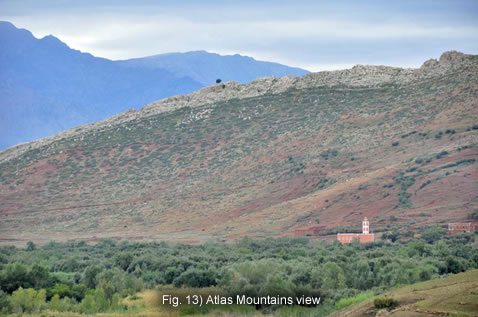


We finally made it to Ouarzazate, checked into the hotel and immediately went to visit the regional Kasbah, a now preserved historic building that was once the seat of power for the regional governor for many centuries. The Kasbah has been well preserved and we had a guided tour that ended at dusk.
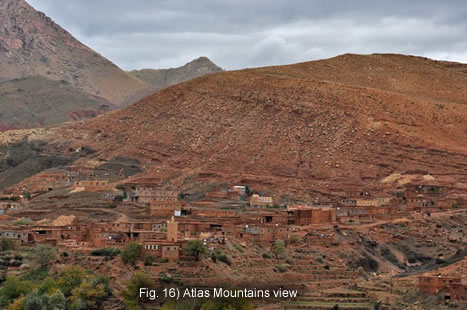
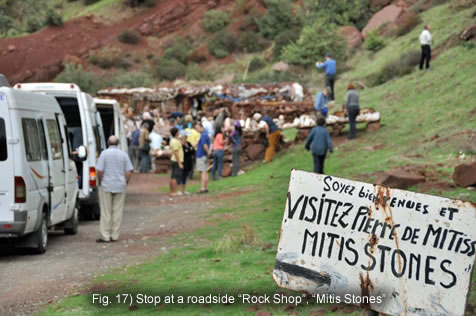
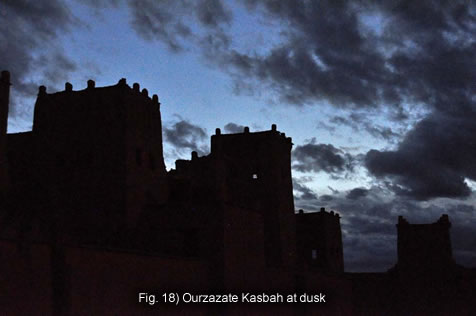
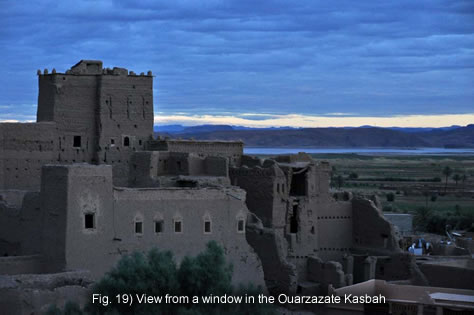
After a superb buffet supper (all the meals were super buffets), a good dose of fine wine and vodka, we watched a snake charmer charm his cobra and put scorpions in his mouth, while playing his clarinet-like instrument all the while.
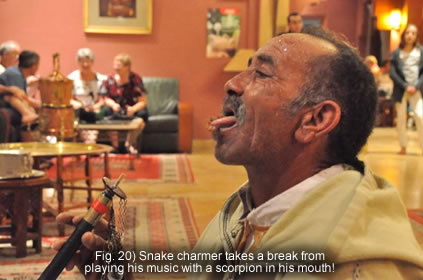
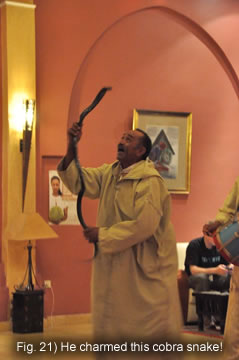
Bou Azer
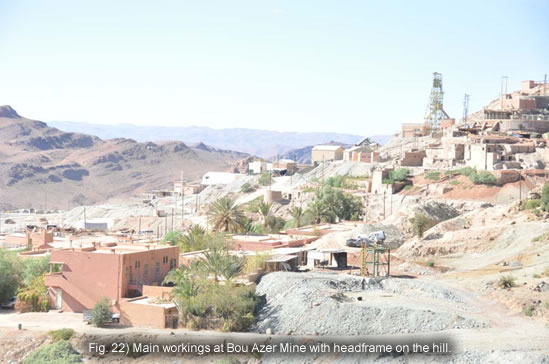
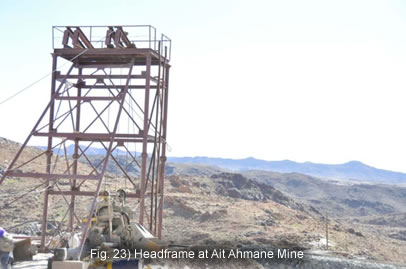
Next morning, on we went to Bou Azer with visions of great mineral specimens dancing in our heads. There are and have been many mines in the Bou Azer District and we had the opportunity to visit a couple of them. Our bus drew the short straw and made our way about as far as you can go in the Bou Azer District to Ait Ahmane, the famous skutterudite locality. The road to Ait Ahmane was very rough and it was a bone jarring drive. About two thirds of the way there, out bus drivers all went on strike. When we finally arrived at Ait Ahmane, the drivers refused to drive the last few km on the little road to the mine. So we hiked in to the mine and were able to find some massive skutterudite, small, well-formed skutterudite crystals, safflorite crystals as well as what has turned out to be cobaltoan austinite in preliminary analyses. It was a short visit but I was glad to see the place and collect.
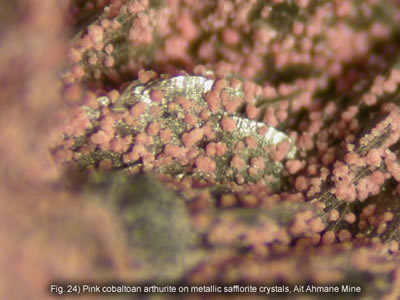
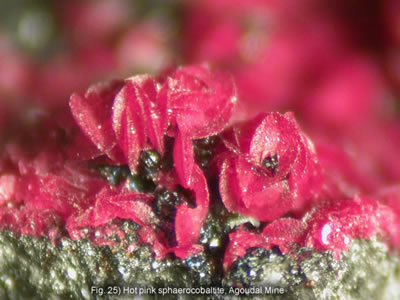
After Ait Ahmane we dropped by Agoudal Quarry. There is an underground mine there and a small open cut with dumps that we were allowed to collect in and on. This is the locality that produces nice cobaltoan calcite, sphaerocobaltite and erythrite. A number of people found nice specimens and I was please to come away with a small cavity with bright red, sharp, sphaerocobaltite crystals lining it.

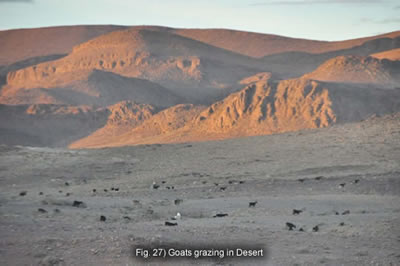
Our travels next took us to Meteorite. It is a small place out in the desert and the hotel could not hold all of the trip participants. We were greeted by another Moroccan folk music band! The hotel set up sort of facsimile Berber tents and beds that were really quite comfortable and Ray and I were happy to sleep in one of those. It had been a long day of collecting and travelling so after supper, most of us just went to bed!
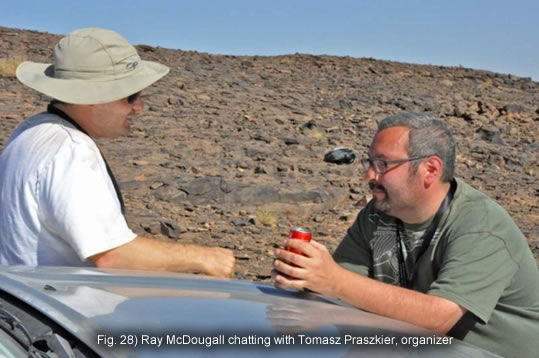
Erg Chebbe Dunes and Taouz
We headed out from Meteorite to a spot that we all would end up enjoying for two nights, the Yasmina Hotel, beside the Erg Chebbe dunes. Really a spectacular spot that gave us a glimpse of the Sahara desert. The hotel is built in a fort-like fashion with all of the buildings inside an enclosure. The pool was fantastic, food very good, and the view of the dunes, spectacular. Each night we were there, we had really good live Moroccan music during and after supper. As usual, Our Polish hosts ensured that there was enough wine to lubricate conversation. It was at Yasmina that I was introduced to Krupnik, the honey laced Polish vodka. Yummm! There was a temporary lake next to the hotel that was, again, a result of the torrential rain that Morocco had received a few days before.
The organizers arranged a fleet of Land Rovers to take us to Taouz! Sometimes they stayed on the road and other times they took off helter skelter across the desert! This locality is a classic vanadinite spot very close to the Algerian border. Taouz was originally a lead mine and some of the workings are still accessible. There are lots of waste rock dumps composed of chunks of oxidized ore consisting of manganese and iron oxides with many cavities containing vanadinite crystals. It was easy to collect there. Again, time was limited but I think that everybody was very happy with the collecting. If only we had more time…
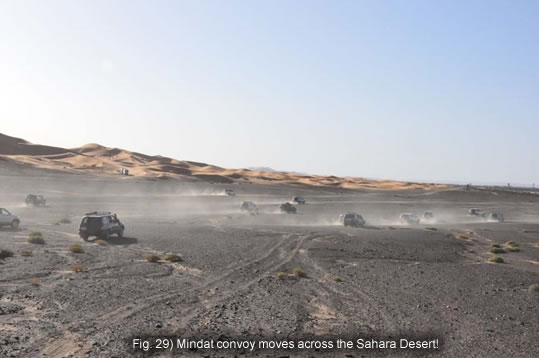
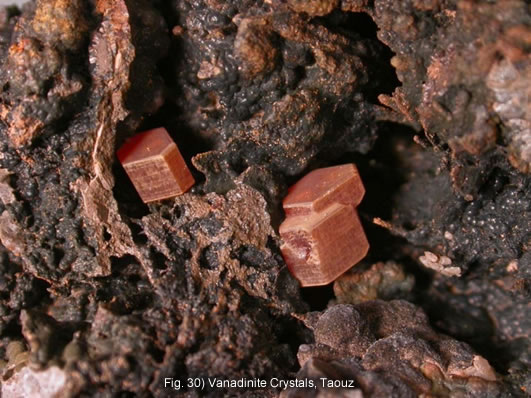
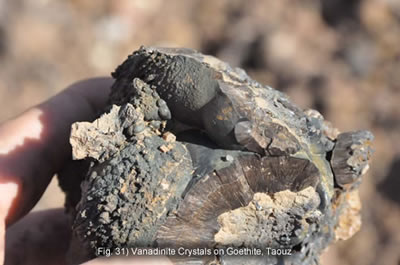

After collecting at Taouz Mine, we headed for a spot near Taouz, where there are ancient rock carvings, and ate our lunch gazing out at the desert, watching grazing camels and the Algerian border.
After lunch, we headed cross-country to get a different view of the Erg Chebbe dunes, enjoying the scenery and the many nomads and their camels that we passed. Pretty darn cool. Back at the Yasmina hotel, we enjoyed a swim to remove the black and brown oxide coatings, another sumptuous feast. One of the highlights of the trip however was the camel ride and then hike up to the higher dunes to watch the sun set. Magic!
From Yasmina we headed for Erfoud to check out the fossil dealers and preparation facilities. I’m not much of a fossil guy but it was pretty neat to see the workers grinding and preparing trilobites. There were some amazing fossils!
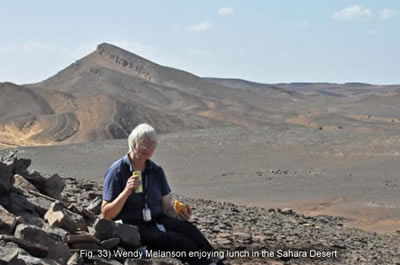


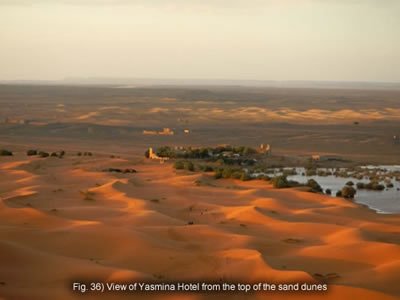
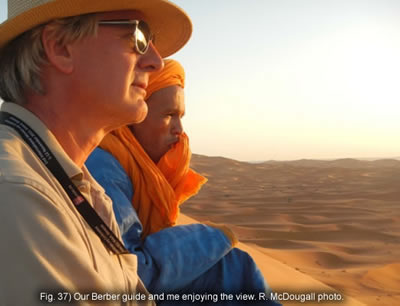
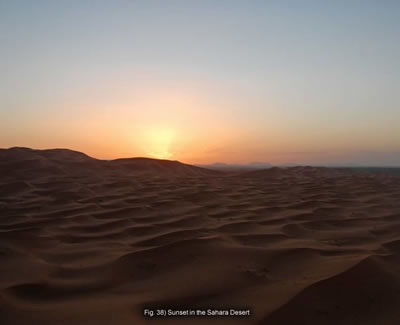
From there we headed off to the fluorite locality at Jorf. It was fun trying to collect but I didn’t have much luck. Ray and I tried attacking an in-situ vein but there wasn’t much well crystallized fluorite in it. I did find some sharp crystals on the dumps but most were heavily, iron stained from near-surface workings. The underground workings seemed to be totally abandoned.
Midelt
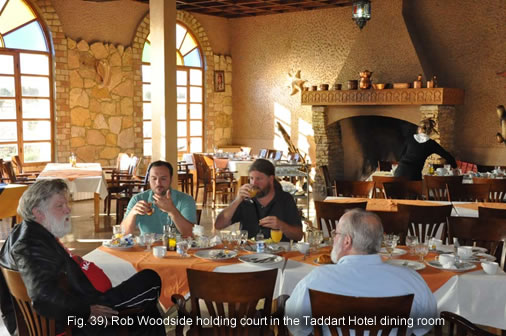
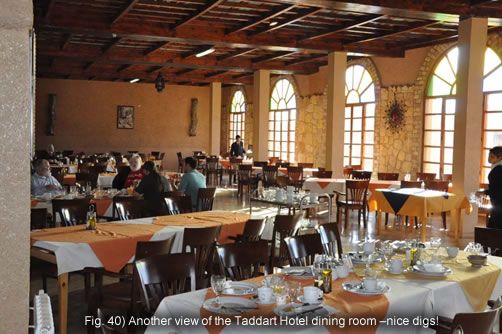
On to Midelt! This was the site of the mindat.org conference. I won’t go into great detail about the conference but it was very good. Essentially, it consisted of three days of presentations by authors knowledgeable about their subjects. Some talks were about Moroccan minerals and localities while others were international. I presented a talk on “The Cobalt Silver District” right after Georges Favreau from France presented his outline of the Imiter Silver District. Attendees seemed to enjoy both talks and comparing the two great silver localities. Every night that we stayed at The Taddart, there was live music and the usual great buffets accompanied by wine and Krupnik. There were two exceptions, however.
One afternoon, the people of Mibladen put on a mineral and craft show featuring many local dealers and artisans with loads of great specimens to purchase. Of course, bargaining seems to be a part of buying minerals in Morocco and lots of that happened. The people of the area put up a great big Berber tent in the middle of the mineral show and treated us to a very nice lunch. After a few hours of bargaining, buying or just looking, they treated us to a wonderful supper! Afterwards we wobbled back to our minibuses and returned to the Taddart Hotel.
On another night, we left the Taddart Hotel for a “secret” spot which turned out to be an abandoned room and pillar mine near Mibladen for ANOTHER great party. This time the people of the area converted the old mine into a banquet hall. They removed the coarse rocks, spread out gravel to provide a smooth floor and then spread out beautiful carpets, brought in tables, chairs, food and served us a several course meal. Again, wine and Krupnik were involved. There was live music, dancing and much socializing. We were all thrilled.

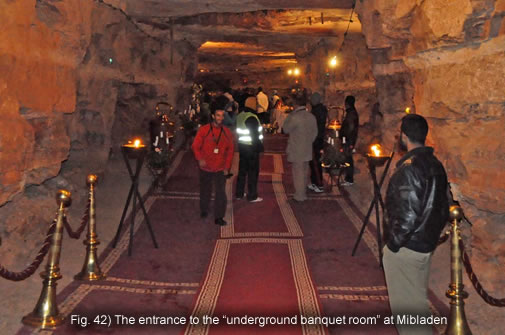
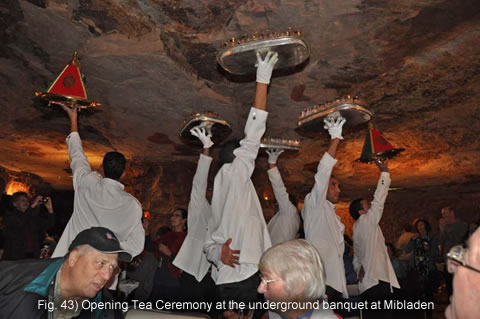
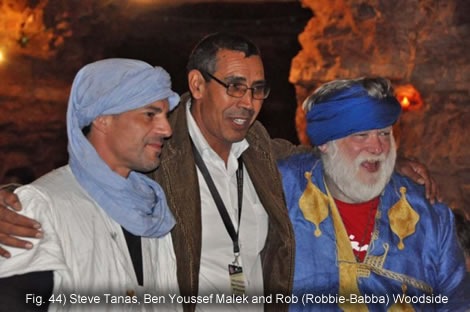
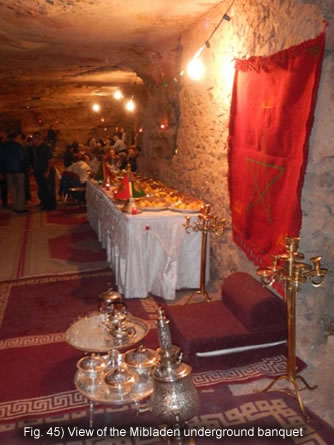
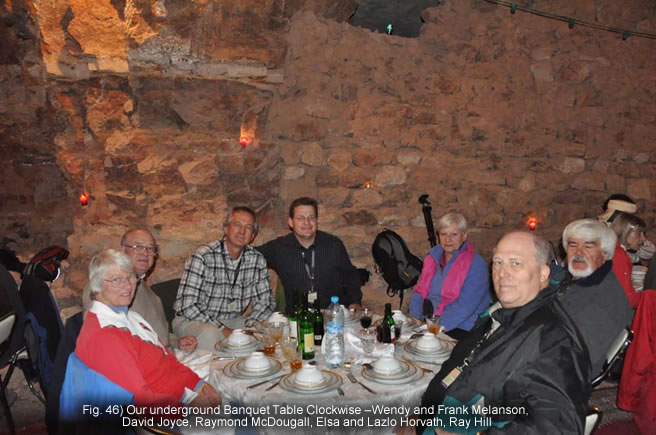

Mibladen Area
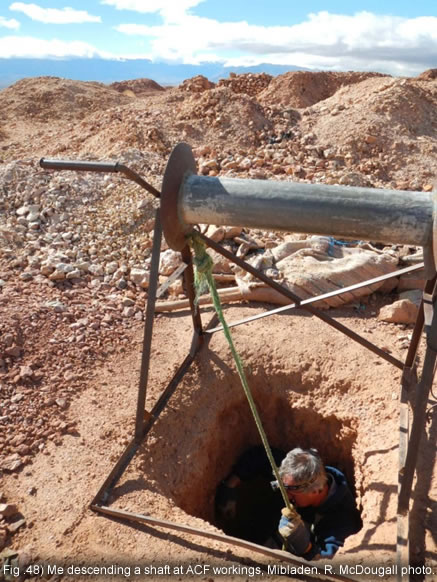
Of course, it would be impossible for us to be several days in the Mibladen/Midelt area without doing some field collecting! The vanadinite and cerussite specimens from that Mibladen are world famous. At one time there were a number of large operating lead mines in the area operated by French companies. There are none operating now but the abandoned workings are constantly being worked by local miners, searching for pockets that contain great crystals. They do find some great ones! They are permitted to collect in the old workings as long as they do not use explosives or power tools.
We first visited the ACF workings which, today, are small independent mines operated by artisanal miners. The vanadinite layers are located about 10m below surface and there are no old workings in them. The miners actually chisel a shaft straight down until they reach the productive layer. This takes about two months! Then they hand chisel the rock until they reach vugs from which they carefully remove the crystals. Hard work! They have small hovels at the top of the shaft that they sleep in if they have discovered something good and don’t want to leave the workings.
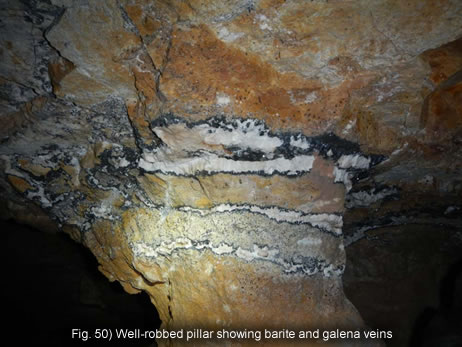

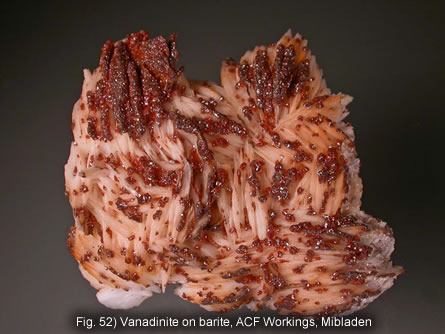
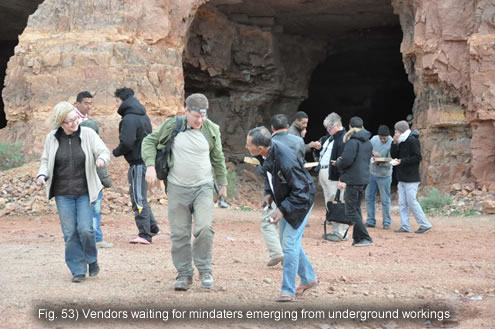
Ray and I visited Abdellah at his workings and went down the shaft with him to try our hand at hand chiselling to find a vug. We spent a couple of hours chiseling and only found some small vanadinite crystals. When we came to surface, we each tipped him and purchase some specimens from him.
The other mines that we visited were actually some of the old room and pillar mines. The pillars still have veins of galena, vanadinite, barite, cerussite and wulfenite in them and that is what we worked on. It was pretty amaizing, really. We just walked into one of the portals and worked our way down to areas that looked promising and just chiselled away at pillars and boulders, hoping to break into vugs with crystals. Again, most people that went underground managed to find some sort of good crystals, cerussite and barite being the most popular finds. I did find a nice yellow wulfenite specimen at Les Dalles but, unfortunately, it was lost on the way home, somehow. We worked at both Boulmaden and Les Dalles which were very similar operations.
Aouli and Sidi Ayed
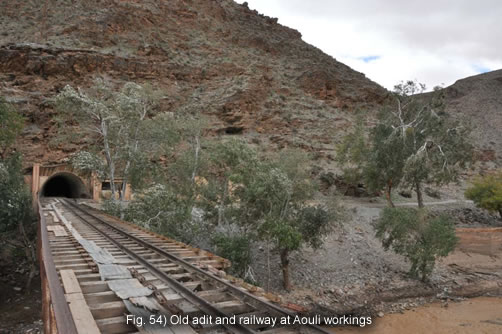

Our last field trip was to Aouli and Sidi Ayed. We had an unusually special old and decrepit car for this final trip on a very cold, windy, rainy day. The car was so special, it had no heat, windows that did not open, no window defogger(a rag to clear the window sufficed), no parking brake(the diver chocked the wheels each stop) and doors with no handles(ropes), not to mention the lack of aesthetic appeal. This probably would not have been too big of a deal on a different day but when we were cold and wet and the windows kept fogging up, it added to the tension of our driver’s insistence that he pass EVERBODY!
Aouli and Sidi Ayed were also mining operations run by French companies but closed in the 70’s and are now totally abandoned except for the brave souls that plumb their depths of mineral specimens. According to our guides, Aouli really has not ever produced much in the way of specmens. Some perhaps but, apparently, most specimens that are labelled Aouli really came from Sidi Ayed. The mine at Aouli was a huge underground mine and I’m glad that we stopped to look around. The buildings that were erected in that steep river valley are amazing. Must have been quite the place in its day! We did not even try to collect specimens at Aouli.
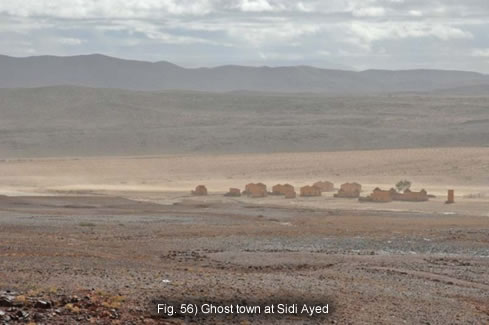
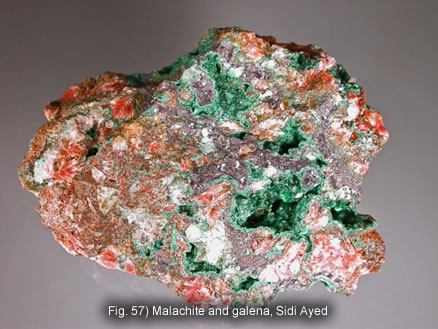
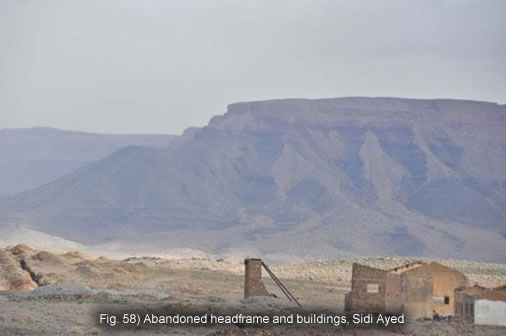
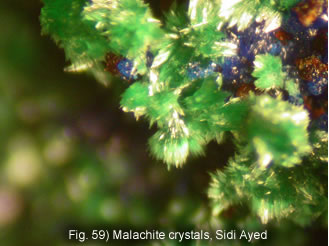
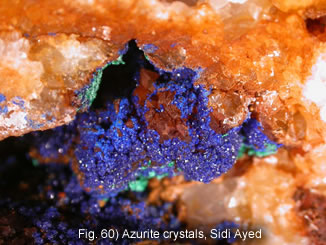
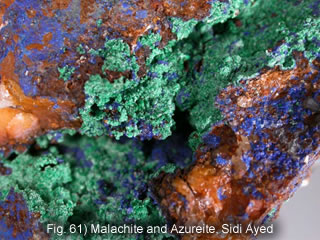
Then on to Sidi Ayed. The road to Sidi Ayed was very rough but our intrepid driver took us right to the end of the road. The end of the road was adjacent to a large open stope and open cuts on a vein that outcropped on surface. There were waste rock dumps on either side of the vein that were loaded with green and blue malachite and azurite. Most of the greens and blues were just fracture coatings but some of the chunks could be broken open to reveal cavities lined with velvety malachite or balls of blue azurite crystals.
The cold winds that blew that day were the forewarning of the snowstorm that was to arrive the next day. Sure enough, overnight, large amounts of snow fell, particularly in the mountains all around us. It was beautiful to look at! The negative effect was that most of the mountain passes were snowed in and impassable for a day or so. As a result people that had flights to catch out of Fez, Casablanca or Marrakech were worried that they might miss them. That resulted in people leaving a day or partially a day early to take the long way around the mountains and avoid the mountain passes. We decided to stay put and enjoy Midelt and the small mineral show of local dealers that was put on at our hotel. We left the next day at our scheduled time, chancing that the mountain pass that we had to traverse would be open by the time we had to cross it. It did work out!
Heading Home
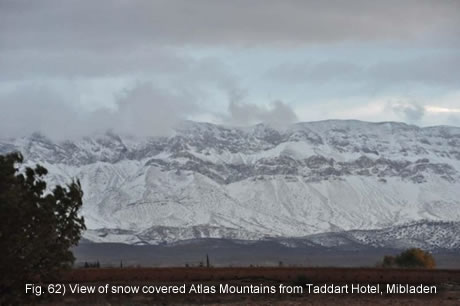
So our seven hour taxi drive from Midelt to Casablanca turned out to be a beautiful drive that started out in cloudy snowy weather and ended up in warm, sunny weather during the drive across a good portion of Morocco. The mountain passes that we had to cross were open and the roads were in great shape. Our driver dropped us off at our hotel in time to catch up on our e-mails before a very nice Moroccan supper. By chance, we ran into two of the key organizers, Tomasz and Agatha in the hotel bar and had a very nice nightcap with them reminiscing the previous two weeks. Nice way to end the trip!
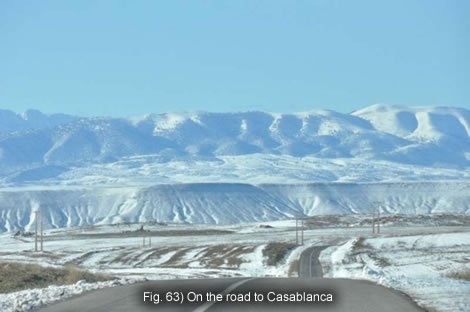
I’d like to acknowledge Jolyon Ralph of mindat.org and Tomasz Praszkier of the Spirifer Geological Society for their tremendous planning, experience, foresight and execution that, along with local partners, provided this unique opportunity to visit an interesting and beautiful part of the world, loaded with great mineral localities.